Welcome to It’s Textured, a column where we untangle the joy, trauma, confusion, and frustration that can come with Black hair. This month, writer Kayla Greaves delves into the controversial practice of heat training—and all the cultural nuances and hair health implications that come with it.
I had no idea what my natural hair texture looked like (or even felt like) until my early 20s. Like many other Black women, I have a complicated relationship with my hair. For much of my life, I never really felt like I was in control of how it looked. From about age four until I hit 23, my hair was relaxed, and not by my choice. Back in the late ‘90s, it was pretty standard for Black mothers to chemically straighten their daughters’ hair. I never had a say at that age—I didn’t even know I could have a say.
My mom was the one who was taking care of my hair, so she made the rules. Even as I entered my 20s—at which point I’d been doing my own hair for quite some time—there still seemed to be rules. I kept up with my relaxer for no real reason other than it was how I was programmed.
Then came the second wave of the natural hair movement, bolstered by YouTubers and bloggers in the early 2010s. Everywhere I went, I saw Black women proudly wearing their voluminous, defined curls, and for the first time, I started to wonder what my hair actually looked like. I grew out my relaxer and focused on enhancing my natural texture—a task that turned out to take a lot of time and energy.
Fast forward 14 years and, to an extent, the reverse revolution seems to be taking place. Although there’s no question that natural curls and kinks are embraced today more than ever before, many Black women, as Allure previously reported, have decided they prefer wearing their hair straight more frequently, using chemical treatments like relaxers, texturizers, or keratin treatments to get there. Most recently, “heat training” has become a buzzy term for maintaining straight strands.
Though Black women have been straightening their hair frequently for decades, the term heat-training more specifically applies to an intentional choice to “train” one’s hair to sustain more modern methods of heat styling, like silk presses and blowouts. While there doesn’t seem to be one agreed-upon method of heat training, it generally involves using a straightening device like a flat iron (or a hot comb if you’re old school) frequently to loosen the natural hair texture. The theory goes that your hair then gets used to all that heat and, in turn, holds straight styles for longer periods of time without reverting to curly or frizzing up or showing the typical signs of damage, like dryness, split ends, and uneven texture.







